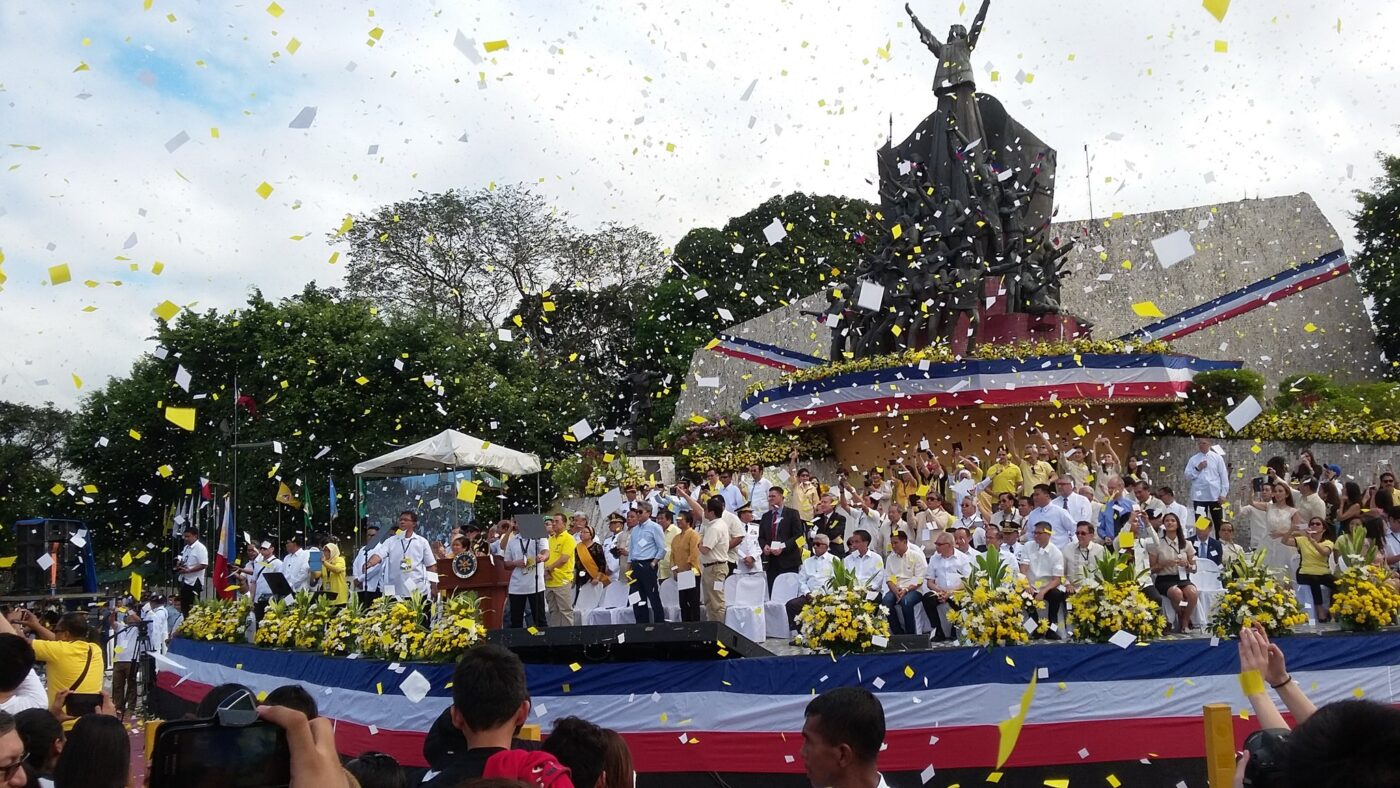WITH THE theme “Pagbabago: Ipinaglaban N’yo, Itutuloy Ko!” this year’s 30th anniversary celebration of the EDSA People Power Revolution sought to bridge the gap between the Martial Law generation and the current youth.
33 students from the Loyola Schools comprised the Ateneo’s delegation to the anniversary program at the People Power Monument in Quezon City. With them were Ateneo Development Studies Program lecturer Urduja Amor and Health Sciences Program Director Norman Dennis Marquez.
The Ateneo youth participation was tapped through Vice President for Social Development Jaime Hofileña, who reached out to Ateneo Task Force Head Mawe Duque to open sign-ups for a contingent February 23. Duque said that even though a 100-person contingent was expected, he was satisfied with the turnout given the late notification and the weeklong anniversary events on campus.
Among the speakers were youth leaders Maria Angela Villa of Milk Matters and Khenn Arquiza of I CAN Make a Difference, initiatives recognized by the Ten Accomplished Youth Organizations. In her speech, Villa said that each generation faces its own challenges and posed the question: “Kung iyon ang EDSA ninyo noon, ano ang EDSA ng kabataan ngayon?”
Reversing revisionism
President Benigno Aquino III, in his last EDSA commemoration as president, took the opportunity to address the youth who are now confronted with revisionist accounts of Martial Law. He countered the so-called “golden age” narrative peddled by some quarters.
“Bilang bahagi ng henerasyong pinagdusa ng diktadurya: Hindi golden age ang panahon ni Ginoong Marcos. Isa itong napakasakit na yugto ng ating kasaysayan kaya nga po naglakas-loob ang napakarami sa ating kababayan na magtipon sa EDSA at sa ibang lugar sa labas ng Metro Manila, tangan ang pananampalataya at paninindigan (“As part of the generation who suffered under the dictatorship, I tell you just as directly: the time we spent under Marcos was not a golden age. It remains one of the most painful chapters of our history—it was why so many of our countrymen mustered the courage to gather in EDSA and in other places outside Metro Manila, armed only with their faith and their principles”),” the president said.
Liberal Party vice presidential candidate and Camarines Sur Representative Leni Robredo also expressed her alarm over the prevalence of revisionist propaganda among the youth.
“It’s scary when you look at social media and they portray Martial Law as one of the best years in Philippine history,” she said, adding the youth have to study the past to understand sacrifices that were made. “Without that appreciation, we will never be able to preserve the gains of EDSA.”
Filipino musician and EDSA veteran Jim Paredes, who teaches part-time at the Department of Communication, agreed. “All of a sudden we could no longer have political discussion in the quadrangle. I would visit some of my teachers, like Bienvenido Lumbera, in jail,” shared Paredes, who was in college when Martial Law was declared in 1972. “I had four classmates who died.”
“Someone paid for your freedom. We did,” said Paredes. “I just don’t want future generations to say that the past—which is now—that the hope of the fatherland actually belonged to the old, not the young.”
Reflecting on EDSA
Paredes’ song “Handog ng Pilipino sa Mundo” was performed among other EDSA anthems. The traditional “Salubungan,” which re-enacts the meeting of forces between opposition troops, included not just veterans of the EDSA revolution but also students from various schools. Helicopters dropped confetti after the Salubungan as former president Fidel Ramos reenacted his iconic jump.
“Sometimes the things we’re taught in classes are just lessons, and it’s different when it becomes an experience,” said Lyka Aguilar, Council of Organizations-Analysis and Discourse Cluster head. Aguilar said the EDSA commemoration presents an opportunity for Ateneans to revive that moment in history and spark discussion.
For Duque, the event is both remembering the struggles of the past and a call to action. “Before, democracy was fought for—now, it’s easily accessible,” said Duque, who pointed out that the youth is a large part of the electorate. “If back then, there was a freedom from [something], then today, how do we use that freedom for?”
Duque added that the youth today are in search of a unifying identity that, for the EDSA generation, was caused by struggle. “For me, identity is also shaped by our enemies,” said Duque. “Dati, kalaban natin diktadurya. Ngayon, sino ang kalaban natin na huhubog sa atin (Before, the enemy was a dictatorship. Today, what is that which forms us)?”
According to Aguilar, commemorations affect campus discourse because they compel Ateneans to discern their role in a modern context. “That’s the thing about Ateneans, if we don’t suffer, we don’t fight for anything,” she said.
“I want to ask Ateneans: Because you don’t suffer, because you are privileged, because you are in a comfortable and safe place, what else is there left for you to fight for? That’s the challenge that EDSA gives us. Ano ang EDSA mo (What is your EDSA)?”




